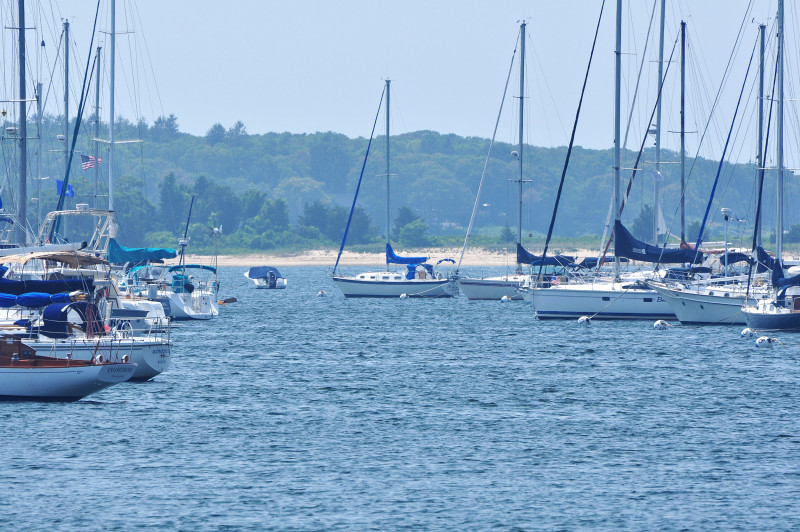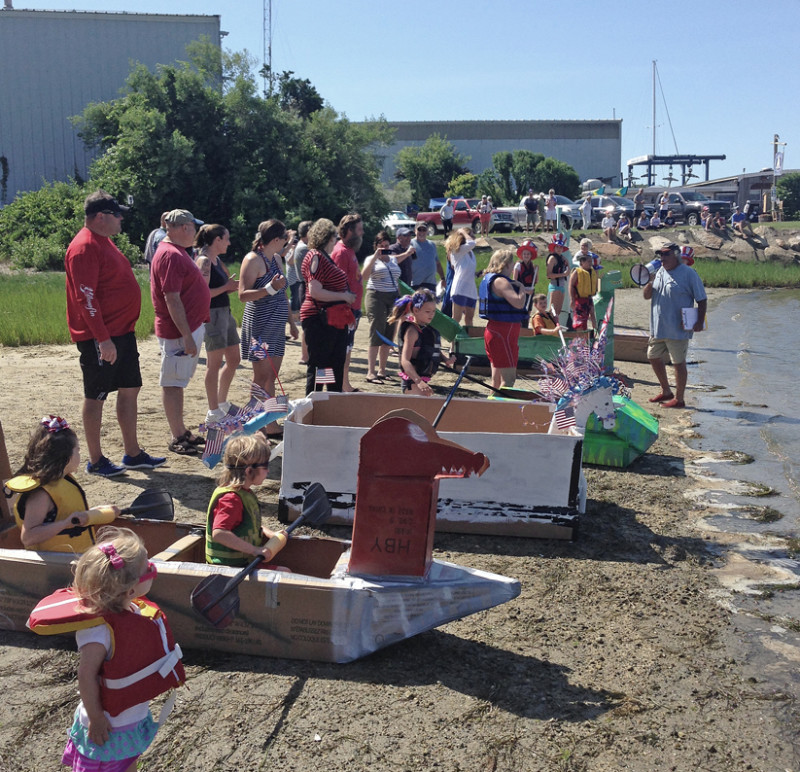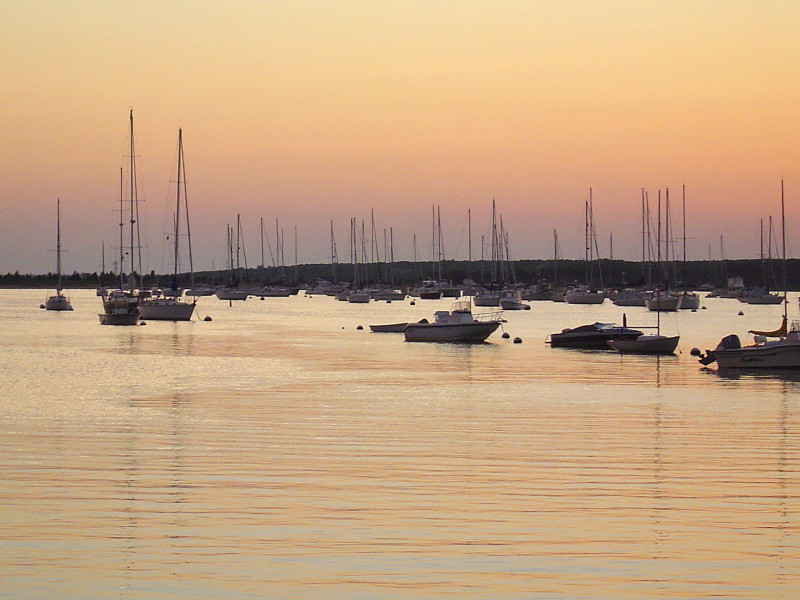How an innovative partnership in Bourne will restore clean water in Red Brook Harbor
On a typical summer afternoon in Red Brook Harbor on Cape Cod, you’ll find thousands of people outside enjoying the water. Hundreds of boats dot the harbor’s surface, tied up to docks and mooring balls or cruising past Bassetts Island into Buzzards Bay. The popular island shelters the harbor from the Bay’s open waters and offers families a mile-long strip of sandy beach where they can swim, picnic, and play.

Sailboats rest by their mooring balls during a calm summer day on Red Brook Harbor.
Beautiful water views are one reason why people flock to Red Brook Harbor, tucked between Wings Neck and Scraggy Neck in Bourne. The other is the harbor’s clear, calm waters, which create a paradise for people who love the outdoors.
But with all those people has come a big problem: nitrogen pollution. Over the past 15 years, the harbor’s health has plummeted, leaving the water green and murky.
Now, local leaders are taking action to reduce the pollution problem and make a difference. By building a new private wastewater facility, a Cataumet marina is planning to eliminate a major source of nitrogen pollution – septic systems – from its neighborhood on the shores of Red Brook Harbor.
Just as importantly, this innovative wastewater project will serve as a model of how private businesses and local communities can work together to stop pollution and save a beloved harbor.
Why is Red Brook Harbor’s health decreasing?
Since 2000, the health of Red Brook Harbor has been in steady decline. The inner harbor’s Health Index – developed with data collected through the Coalition’s award-winning Baywatchers monitoring program – now hovers around 40. That’s alarmingly close to what the Coalition considers poor health. Compare that figure to the mid-1990s, when the inner portion of Red Brook Harbor scored an excellent health of about 80.
The reason for this drop in the harbor’s health is nitrogen pollution. When too much nitrogen gets into the water, it fuels the growth of algae blooms that lead to murky water, less oxygen, fewer eelgrass beds, and lower fish and shellfish populations. These conditions harm underwater life, but they also make the water pretty unappealing for people, too.
The biggest source of nitrogen pollution to Red Brook Harbor is home septic systems. Traditional septic systems remove bacteria, but not nitrogen. So nitrogen seeps into the groundwater and ends up in our waterways. When there are lots of homes on septic systems located near the water — like on Red Brook Harbor — they become a big problem for the health of our waterways.
One community like this is Cedar Point, a neighborhood of about 100 homes in Pocasset village. Like many long-established seaside communities on Cape Cod, Cedar Point’s houses are hooked up to individual septic systems.
The pollution problem is clear to everyone who spends time on the harbor — particularly boaters. Red Brook Harbor is home to Kingman Yacht Center, Cape Cod’s largest marina facility.
Owner Scott Zeien learned how to swim and sail in Red Brook Harbor when he was young, and his children have grown up boating on the harbor as well. “I envision the possibility of my kids operating the marina someday,” he said. “But the thing that could mess that up is nitrogen pollution.”
Based on cleanup plans from similar nearby harbors like Phinneys Harbor and West Falmouth Harbor, the Coalition estimates that Red Brook Harbor is receiving twice as much nitrogen pollution as it can handle.
A cleanup plan is also required for Red Brook Harbor that would limit the amount of new nitrogen that can go into the harbor. But so far, that plan hasn’t been completed.
“To restore the harbor, we must clean up existing septic systems discharging nitrogen to the water and make sure new sources of nitrogen don’t make the problem worse,” said Korrin Petersen, the Coalition’s senior attorney.
How are local businesses working to restore Red Brook Harbor?

Kingman Yacht Center gets kids and families out on Red Brook Harbor during the marina’s annual “cardboard regatta.” (Image: Kingman Yacht Center)
Zeien, the Coalition, and other local leaders aren’t letting Red Brook Harbor’s pollution problem get any worse. They’re investing resources now to tackle the source of all that nitrogen pollution: wastewater.
To get the marina off septic systems, Kingman is constructing a private neighborhood-scale wastewater facility that will treat sewage from the marina and a new development of 15 townhomes next door called the Red Brook Harbor Club. The wastewater facility will use advanced technology to remove much more nitrogen than septic systems.
The private wastewater facility will be able to treat more sewage than the marina and the new townhomes will produce. So Zeien is proposing a solution that will cut down pollution not just from his properties, but from the nearby Cedar Point neighborhood. The facility will be able to take wastewater from about 52 Cedar Point homes, which would remove those homes from septic systems.
“There’s no other entity locally that has the resources to pull something like this together,” Zeien says about why he decided to take action to reduce pollution to the harbor. “I felt like I had an obligation to the harbor and the future of the business to do something.”
By connecting the marina, the new townhomes, and the Cedar Point neighborhood to an advanced wastewater treatment facility, the Coalition estimates that will reduce nitrogen pollution to Red Brook Harbor by approximately 2,400 pounds per year – a substantial reduction in the amount of nitrogen pollution currently seeping into the harbor.
Clean water is in the business interest of the marina and the new townhome development, too. If the harbor isn’t clean, fewer people will want to live along it or put their boat in it.
“The long-term future of this business depends in large extent on the health of the harbor,” said Zeien. “When people can’t swim at the beach because it’s all green, why would they want to come here anymore?”
How will this project reduce costs for the local community?

Red Brook Harbor at sunset.
There’s a reason why many communities around Buzzards Bay haven’t upgraded their wastewater treatment facilities to reduce nitrogen pollution: it’s expensive. And homeowners are usually the ones who have to pay those costs through loans, fees, and tax increases.
“Town meetings usually don’t approve projects that carry a heavy financial burden for voters,” explained Petersen. “Therefore, time and again projects that are one hundred percent publicly funded fail, and no nitrogen pollution cleanups occur.”
That’s what makes the initiative on Red Brook Harbor so unique and important. As more and more waterways show signs of nitrogen pollution, communities across the region need to think creatively about how to fund projects to reduce pollution and improve wastewater treatment.
“Having a private developer shoulder some of this financial burden helps make the projects more affordable for homeowners,” said Petersen, who is managing the Red Brook Harbor project for the Coalition.
In Bourne, the town allowed the new townhome development to be built more densely in exchange for improved wastewater treatment infrastructure. This law, passed four years ago, opened the door for innovative community partnerships like what’s happening now on Red Brook Harbor.
By constructing a new wastewater facility, Zeien estimates that he’s defraying about half of the cost that homeowner would pay to install an advanced nitrogen removal septic system themselves. “We can provide better treatment at half the cost,” he said.
With a recent $50,000 grant from the Southeast New England Coastal Watershed Restoration Program, the Coalition will work to create a public-private partnership that will finance and implement the wastewater facility project. Working with engineers, the Coalition will also design the wastewater collection system for the Cedar Point neighborhood and develop a public outreach plan to get the word out about the project.
Zeien hopes that the Coalition’s involvement will provide a blueprint that he can show town officials to encourage them to tie in homes that choose connect to the wastewater facility instead of septic systems, which will make a huge difference for the harbor’s health.
“A year from now, this system will be up and running, waiting for people to plug into it,” said Zeien.
In the eyes of both Zeien and Petersen, this partnership between private businesses and local communities is a model that could – and must – be replicated throughout the region to reduce costs and protect clean water.
“Opportunities like this exist throughout Cape Cod and Buzzards Bay,” said Petersen. “This example will be useful to communities and developers in towns like Wareham, Falmouth, Mattapoisett, and Westport.”
On Red Brook Harbor, at least, the future appears to be filled with more summer days that Zeien and thousands of others have enjoyed for years – clear water, clean beaches, and happy memories to last a lifetime.